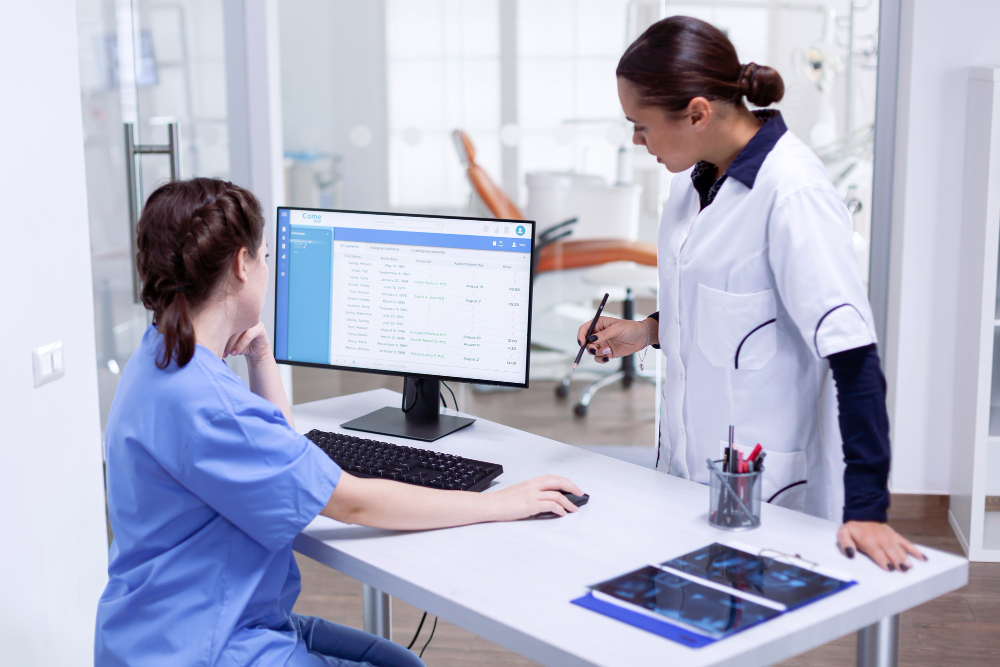In today’s healthcare landscape, staying ahead requires embracing cutting-edge technologies that redefine the standards of efficiency, compliance, and competitiveness. These innovations empower healthcare providers and clearinghouses alike to streamline operations, optimize patient care, and confidently navigate complex regulatory landscapes.
By integrating advanced technologies like artificial intelligence, blockchain, and real-time analytics, organizations can forge a path toward sustainable growth and excellence in healthcare billing processes.
The Role of Technology in EHR Clearinghouse Services
Medical claim clearinghouses are crucial in facilitating seamless billing processes through advanced technology, workflows, and specialized expertise.
They act as vital intermediaries between healthcare providers and payers, ensuring accurate claims processing and timely reimbursements. These clearinghouses leverage vital technologies such as value-based care and MIPS interoperability, supported by robust, secure, and cloud-based settings.
This integration enhances data security and fosters interoperability across healthcare systems, paving the way for efficient claims management and improved financial outcomes
Emerging Technologies in Clearinghouse Services
As electronic medical record (EMR) software advances, these innovations are increasingly relevant to clearinghouse services:
Holistic Integration
Seamless integration with diverse healthcare platforms ensures smooth claims processing across interconnected technologies. This integration goes beyond mere connectivity, fostering a unified ecosystem where data flows seamlessly between EMR systems, billing software, and payer portals.
By eliminating silos and standardizing data formats, healthcare providers can streamline administrative tasks, improve patient care coordination, and reduce operational costs.
Holistic integration supports real-time data sharing, allowing providers to access comprehensive patient information efficiently, enhancing clinical decision-making and overall care quality.
Centralized Databases
Consolidating data into a unified repository enhances data management and accessibility, streamlining billing processes.
A centralized database acts as a secure vault where all patient and billing information converges, ensuring consistency and accuracy across healthcare operations.
By centralizing data storage, healthcare organizations can simplify compliance with regulatory requirements, improve data security measures, and expedite claims processing.
Accessible from various points within the healthcare network, centralized databases facilitate efficient data retrieval, enabling timely billing and reimbursement cycles.
Virtual Care
Support for virtual care platforms facilitates the effective handling of claims from telemedicine visits.
Integrating virtual care capabilities into clearinghouse services is essential in an era where remote healthcare delivery is increasingly prevalent. Clearinghouses equipped for virtual care support enable seamless billing and reimbursement for telehealth consultations, ensuring compliance with evolving regulatory standards.
This integration extends beyond traditional office visits, accommodating remote patient monitoring, telepsychiatry, and other telemedicine modalities.
By bridging the gap between virtual care technologies and billing processes, healthcare providers can expand their service offerings while maintaining financial sustainability.
Integration Features
Advanced integration capabilities enable seamless data exchange between healthcare systems, ensuring interoperability.
These features empower clearinghouses to communicate effectively with EMR systems, practice management software, and third-party payer platforms. Integrating features facilitates automated workflows and real-time updates across disparate systems by standardizing data formats and protocols.
This interoperability enhances administrative efficiency, reduces manual errors, and accelerates claims processing timelines. Advanced integration capabilities also support collaborative care initiatives, enabling healthcare teams to access unified patient records and coordinate care seamlessly across specialties and facilities.
Robotic Processes and Automation
Automation of repetitive tasks reduces errors and processing times in claims management.
Robotic process automation (RPA) empowers clearinghouses to automate routine administrative processes, such as claim submission, eligibility verification, and payment reconciliation.
By leveraging algorithms and machine learning, RPAs streamline workflows, improve accuracy in claims adjudication, and expedite revenue cycle management.
Automated processes minimize human intervention, reducing operational costs, enhancing scalability, and freeing staff to focus on patient care and strategic initiatives. RPA also supports compliance with industry regulations and payer requirements, ensuring consistent and efficient claims processing.
Big Data Analytics
Big data for predictive analytics enhances decision-making, revenue cycle management, and operational efficiency.
Clearinghouses harness big data analytics to extract actionable insights from vast healthcare data. By analyzing historical claims data, demographic trends, and payer behaviors, analytics tools provide predictive models that optimize revenue cycles, identify billing patterns, and mitigate claim denials.
Real-time analytics dashboards empower stakeholders to make informed decisions, monitor key performance indicators, and proactively address revenue challenges. Big data analytics also supports population health management initiatives, enabling proactive care interventions and improving patient outcomes.
Real-Time Alerts
Instant notifications for claim statuses and issues enable proactive management and faster issue resolution. Clearinghouses equipped with real-time alert systems provide timely updates on claim status changes, payment delays, and compliance issues.
These alerts empower healthcare providers to take immediate action, such as resubmitting claims or resolving billing discrepancies, to minimize revenue cycle disruptions. Real-time alerts improve cash flow predictability by facilitating proactive management strategies, reducing claim processing bottlenecks, and enhancing overall operational efficiency.
Advanced Reporting
Comprehensive reporting tools provide insights into financial performance and billing trends, empowering informed decision-making.
Clearinghouses leverage advanced reporting capabilities to generate customizable reports on key performance metrics, such as claim submission rates, denial rates, and reimbursement turnaround times.
These reports enable healthcare organizations to identify revenue cycle inefficiencies, optimize billing processes, and comply with regulatory reporting requirements. Advanced reporting tools facilitate strategic planning, budget forecasting, and benchmarking against industry standards by visualizing data trends and patterns.
Telemedicine
Integration with telemedicine platforms supports billing for remote consultations and treatments.
Clearinghouses enable seamless billing for telehealth services, including virtual visits, remote patient monitoring, and telemedicine-enabled procedures.
Integration with telemedicine platforms ensures accurate capture of telehealth-related charges, compliance with telehealth billing regulations, and seamless reimbursement from payers.
This integration enhances patient access to care, expands healthcare delivery options, and improves patient satisfaction. By supporting telemedicine initiatives, clearinghouses contribute to enhanced care coordination and continuity of care across virtual and in-person settings.
EHR Blockchain for Data Security
Blockchain technology ensures secure, tamper-proof transactions, enhancing data integrity across healthcare operations.
Clearinghouses leverage blockchain-based electronic health record (EHR) systems to encrypt and store patient data securely. Blockchain’s decentralized ledger system provides immutable records of patient encounters, billing transactions, and treatment histories, protecting sensitive information from unauthorized access and cyber threats.
By implementing EHR blockchain solutions, clearinghouses enhance data privacy, comply with regulatory mandates (e.g., HIPAA), and build patient trust in data security measures.
Blockchain-enabled EHRs facilitate interoperability among healthcare stakeholders, enabling seamless data exchange while maintaining data integrity and authenticity.
Voice Recognition and Transcribing
Automated transcription of clinical notes through voice recognition enhances accuracy and operational efficiency.
Key Features of Clearinghouse Technology
Understanding core functionalities such as data processing, claims submission, and payer interactions is essential for selecting the right service provider.
Clearinghouses effectively handle large amounts of healthcare data. They ensure accuracy in patient demographics, procedural codes, and insurance details. Validating claims quickly and correctly helps prevent claim denials and delays
-
Claims Submission
Clearinghouses electronically submit claims to multiple payers, following each payer's specific rules. Automated processes speed up submissions and improve accuracy, helping providers get paid faster.
-
Payer Interactions
Clearinghouses manage communications with payers through portals and direct connections. They provide real-time updates on claim status and payment, making resolving issues and negotiating reimbursements easier.
-
Compliance Management
Clearinghouses adhere to HIPAA and other regulations to protect patient data and follow payer guidelines. They integrate compliance checks into their systems to avoid penalties and audits.
-
Reporting and Analytics
Clearinghouses offer customizable reports that show financial performance and claim trends. These analytics provide insights into revenue management, helping providers improve billing strategies and financial outcomes.
-
Integration Capabilities
Clearinghouses integrate with practice management software, telemedicine platforms, and EMR systems. This smoother data exchange improves care coordination and reduces administrative work.
-
Customer Support and Training
Clearinghouses support software updates, technical issues, and system optimization. Training programs help staff use clearinghouse tools effectively, ensuring smooth operations.
-
Scalability and Flexibility
Clearinghouses offer scalable solutions for practices of all sizes. They use cloud-based systems to support growth and accessibility, allowing secure access to billing data from anywhere.
-
Innovation and Future-Readiness
Clearinghouses stay updated with AI and predictive analytics advancements. They innovate to improve data security, efficiency, and patient care, preparing for future healthcare trends. Understanding these features helps healthcare providers choose the right clearinghouse
Providers can manage revenue effectively and streamline operations by focusing on efficient data processing, accurate claims submission, practical payer communication, compliance, reporting, integration, support, scalability, and innovation.
Benefits of Clearinghouse Technology
Clearinghouse technology offers significant benefits to healthcare providers:
- Clearinghouses expedite claims processing, ensuring faster reimbursements and improved cash flow. They also minimize errors in claims submissions through advanced validation processes, reducing claim denials and rejections.
- Clearinghouses enhance operational efficiency by automating administrative tasks and streamlining workflows, allowing providers to prioritize patient care and strategic initiatives. Overall, leveraging clearinghouse services optimizes revenue cycle management, improves financial outcomes, and supports sustainable growth in healthcare practices.
Embracing Innovation in Clearinghouse Services
Embracing emerging technologies in your clearinghouse services isn’t just about keeping pace and gaining a strategic advantage. These innovations streamline billing processes, enhance patient care delivery, and position your organization competitively in today’s dynamic healthcare landscape.
Contact us today for more information on how Harris Caretaker can optimize your clearinghouse operations.






